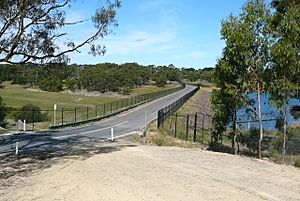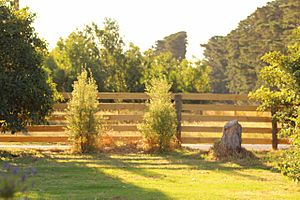Devilbend Natural Features Reserve facts for kids
Devilbend Natural Features Reserve is a huge park, about 1,005 hectares big! It's located on the Mornington Peninsula in Australia, about 55 kilometers south-east of Melbourne. This special place is on the traditional land of the Bunurong people. The reserve has two old water reservoirs, Devilbend and Bittern. These reservoirs were the main reason this land was kept safe and undeveloped for a long time.
Contents
A Look Back in Time
The smaller Bittern Reservoir was built first, in the 1930s. It could hold about 573 million liters of water.
The larger Devilbend Reservoir was built later, in the 1960s, and opened in 1965. It can hold a massive 14.6 billion liters of water! This makes it the biggest freshwater body on the Mornington Peninsula. Both reservoirs used to provide drinking water to the Peninsula. However, they were no longer needed after a new water pipeline was finished in December 2000.
In September 2006, most of the Devilbend land was given to Parks Victoria. The Devilbend Natural Features Reserve officially became a park on March 8, 2007. Plans were made to turn the area into a place for visitors.
Reopening to the Public
In 2012, after six years of work and a budget of $1.6 million, the Reserve reopened to the public. It was officially named Devilbend Natural Features Reserve. Many new things were added to the park. These included a new entrance, a paved road, a sealed car park, picnic and barbecue spots, walking paths, and a boardwalk.
By the end of 2017, Parks Victoria allowed non-powered boats, like canoes or kayaks, on the lake.
Nature's Home
Most of the natural bushland on the Mornington Peninsula has been cleared over time. It's thought that less than 5% of the original natural areas are left. Devilbend is one of the few places on the Peninsula that still has large areas of native plants.
More than 200 types of native plants have been found here. These include trees, shrubs, ground plants, water plants, and beautiful orchids. Other big areas of bushland on the Peninsula are at Point Nepean, Green's Bush, and HMAS Cerberus.
Amazing Wildlife
Because the public couldn't access Devilbend for a long time, it became a great home for wildlife. Many waterbirds and frogs live here. The Devilbend Reservoir, which is 243 hectares, is so important for birds that BirdLife International has called it an Important Bird Area (IBA). This is because it's a seasonal home for over 1% of the world's population of the blue-billed duck, which is a near-threatened species.
The reserve also has the only nesting spot for the white-bellied sea eagle on the Mornington Peninsula. Other special animals found here include the growling grass frog and the tiny dwarf galaxias fish.
In total, 44 different kinds of birds have been counted in the Reserve. In 2005, 140 types of native plants were found.
Fishing Fun
Starting in 2010, the reservoir began to be stocked with fish for fishing. They added 14,000 rainbow trout and 21,000 brown trout. Some of these first fish were eaten by native perch.
A group called the Devilbend Foundation was created in 2002. They wanted to stop fishing and horse-riding in the park. They believed it would upset the natural balance of the park. However, in November 2017, the Victorian Fisheries Authority released 180 large brown trout into the Reservoir. These fish weighed about 2.5 kg each and were added to "improve the mixed fishery." Between 2010 and 2017, a total of 100,000 trout were put into the Reservoir.
Images for kids
-
Red-eared slider turtles were also spotted in the reserve.






